#tryphaena
Explore tagged Tumblr posts
Text
"Why Should I Get Involved?"
DeStefano points out this amazingly simple yet propfound truth: When we help someone we reduce the amount of suffering in the world, we become part of the process of God working things together for good.
Published almost twenty years ago, “Ten Prayers God Always Says Yes To” by Anthony DeStefano changed how I pray and how I experience God’s answers to my prayer. I’ll be spending the next few weeks talking about what I got from his book, and how applying the principles in this book to my own life changed me. Phoebe, Risk–Taker Exraordinaire “I commend to you our sister Phoebe, a deacon of the…

View On WordPress
#andronicus#anthony destaefano#Apostle Paul#Aquila#Destefano#epaenetus#junia#Mary#nereus#nlia#Paul#persis#phoebe#Prayer#prisca#Priscilla#Romans 16#rufus#Ten Prayers God Always Answers#tryphaena#tryphosa
0 notes
Text
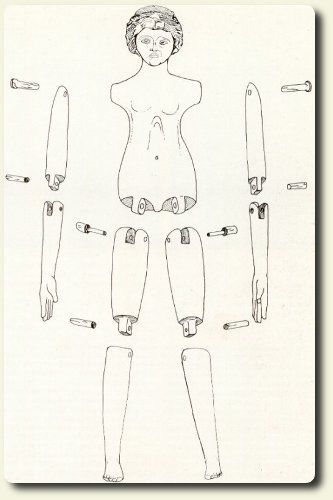
Drawing of parts of the "wooden" doll of Crepereia Tryphaena 2nd/3rd centuries A.D. At first the doll was assumed to be made of wood, but in fact it was carved from ivory, which was stained dark brown over the centuries by the water of the Tiber which had seeped into the sarcophagus.
When the doll was found she still wore one jewel, a ring with a key set on her right hand's thumb. Her ears were pierced, proving that she wore earrings probably the two perforated pearls found in the grave. Also found were two small golden circlets kept together by a golden ring: most likely a light armlet. Small prisms of pierced green paste and little golden spirals were probably all that remained of her rings.
CDHM The Miniature Way iMag, Dollhouse Tourism, October 2010, Issue 9
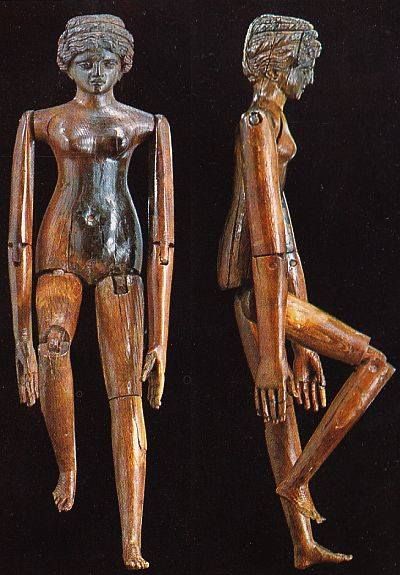
33 notes
·
View notes
Text
of the archaeological discoveries i've studied and seen, perhaps the one that had the biggest impact on me is that of crepereia tryphaena.





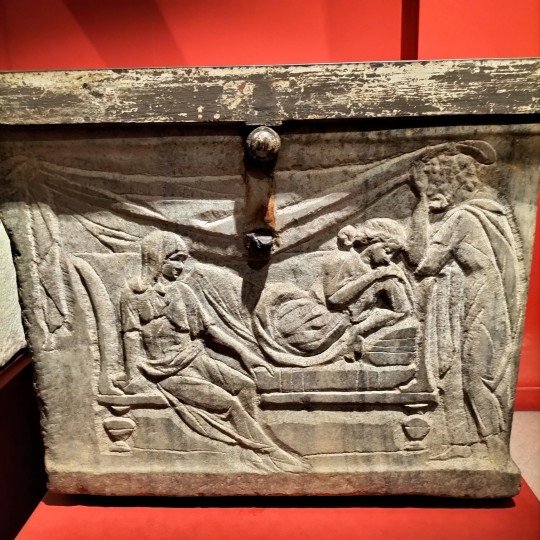
my pictures (you can literally see my reflection)
now displayed at centrale montemartini in rome, crepereia tryphaena was a young woman, of about 20 years old, whose sarcophagus was found during the excavation works started in 1889 for the foundations of the palace of justice and for the construction of the umberto I bridge over the tiber in rome. the sarcophagus, engraved with a scene alluding to the girl's death (last row of pictures on the right), was found with four more, all buried between the middle of the 2nd century and the 3rd AD. only two were still sealed: that of tryphaena and crepereius euhodus, buried at the bottom of a well later filled with earth, and placed side by side and decorated only on two sides, like in a double burial.
the funeral equipment, present only in the tryphaena sarcophagus, included many gold ornaments (the intact skeleton of the girl was still adorned with several jewels and a crown of myrtle leaves blocked by a barrette made with small silver flowers. at the time of her burial she wore gold and pearl pendant earrings and a gold necklace with pendants formed by small beryl crystals, and er tunica was held by a gold brooch adorned with an engraved amethyst bezel), and placed next to her skeleton there was an ivory doll with her own doll's kit, matching the jewels of tryphaena. the presence of the doll in the funeral outfit may suggest that she died on the eve of her wedding, not having had time to donate her toys to the gods in the "farewell to childhood" ceremony.
the panel at the museum reads:
Crepereia Tryphaena On 10 May 1889, during the excavations for the construction of the Courthouse in the Prati district, an incredible discovery unearthed two sarcophagi placed next to each other, which held the remains of Crepereia Tryphaena and Creperio Euhodus. The discovery aroused great excitement, as one of the sarcophagi contained the body of a girl, lovingly placed with her opulent trousseau and her ivory doll. We do not know if Crepereia was a young bride or a girl who was soon to be married, but two of her rings, a carnelian signet ring with two clasped hands and another engraved with the name Filetus, immediately brought to mind a wedding ring and the name of her future husband.* Crepereia belonged to a family of wealthy freedmen, or descendants of freedmen, originating from a Greek-speaking region, perhaps Egypt or Syria, as demonstrated by the names of the deceased. The extremely refined manufacture of the doll is probably that of artisans from the city of Alexandria in Egypt. The burial area in the Gardens of Domizia, a property that passed into Imperial ownership during Nero's reign, leads us to believe that the Creperii were given the privilege of being buried here for their lead role in the administration of imperial property. The burial can be dated back to the mid-second century AD, a chronology that is also confirmed by the doll's coiffure, realistically inspired by the Antonine hairstyles of the time, and in particular the trend introduced by Empressed Faustina the Elder and Faustina the Younger. Even the doll had its own miniature trousseau; the objects were inside an elegant ivory and bone box, which was perhaps meant to be opened by the small key hanging from the ring in the doll's hand.
the trousseau and some details (pictures not mine):


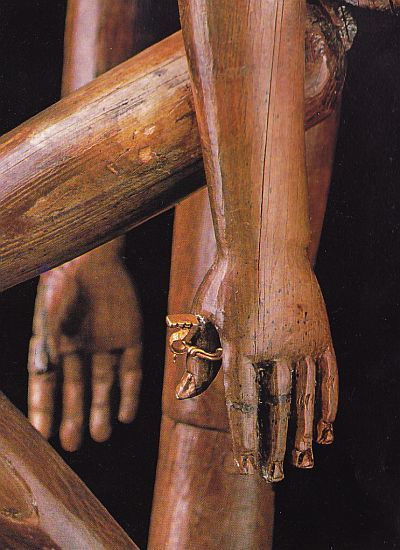
*because of this giovanni pascoli, italian poet, composed a poem in latin which he presented on the occasion of the wedding of the daughter of the honourable benzoni, minister of public education of the time

the water imagery comes from the opening of the sarcophagus itself, which was still sealed: the young woman, submerged in the water coming from the nearby tiber river, "appeared as a nymph". archaeologist rodolfo lanciani wrote:

both her skeleton and that of crepereius euhodus are still preserved inside the sarcophagi
#paiawon.txt#crepereia tryphaena#archaeoblr#archaeology#roman archaeology#archeological discovery#poetry#italian poetry#italian poet#giovanni pascoli#latin poetry#rome history#centrale montemartini#rome museum#art history#artblr#studyblr#artefacts#antiquities#antiquity#classical antiquity#archaeology tag
8 notes
·
View notes
Text
A Roman doll with moveable joints and accessories was found in the sarcophagus of Crepereia Tryphaena, an unmarried 20-year-old woman. The sarcophagus is dated to the late 100s (2nd c. AD) making the ivory “Crepereia Doll” nearly two thousand years old.
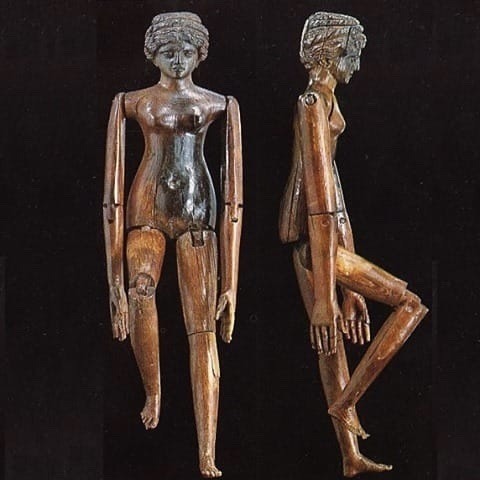
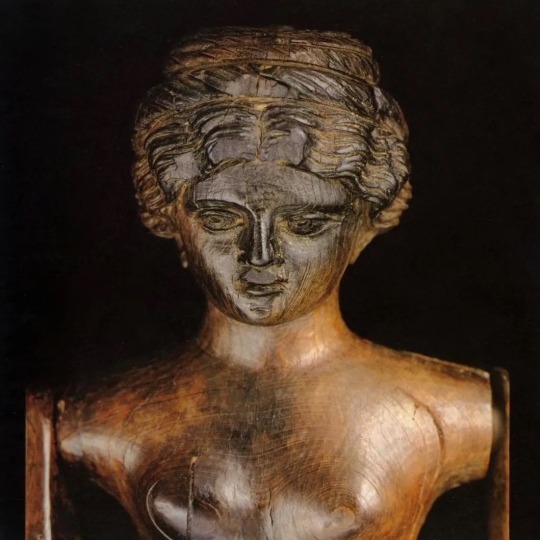
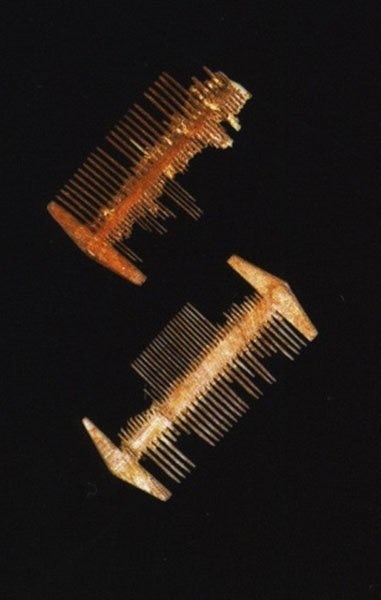
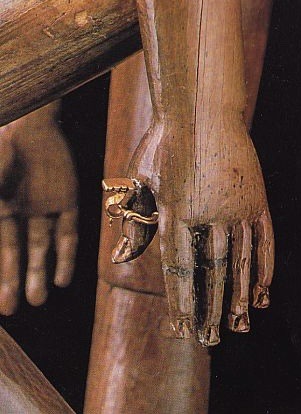
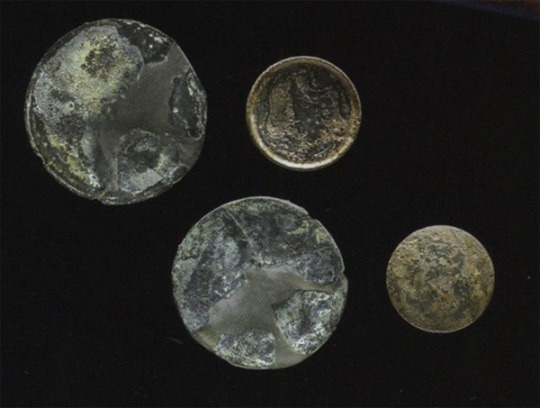
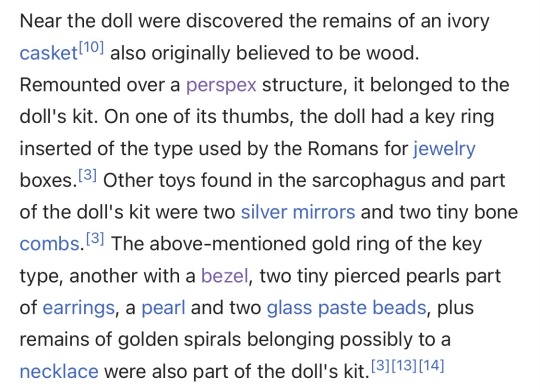


#its so beautiful#sculpture#rome#ancient rome#roman empire#history#classical history#classics#ancient history#dolls#barbie#barbie movie#fun facts#interesting#aesthetic#history aesthetic#archaeology#museum#artifacts#relics#antiques#womens history#interesting history#roman#roman art#roman sculpture#handmade#artisan#crafts#doll
6K notes
·
View notes
Photo

Cleopatra & Antony
Regarded by the Romans as "fatale monstrum" – a fatal omen – Cleopatra is one of the ancient world's most popular, though elusive figures. The Egyptian queen has been immortalized by numerous writers and filmmakers, most popularly by William Shakespeare in Antony and Cleopatra, and by Hollywood in Cleopatra (1963), starring Elizabeth Taylor and Richard Burton. The latter work features the memorable image of the enticing young Cleopatra emerging gracefully from an unfurled carpet in front of Roman general Julius Caesar. But is Cleopatra to be regarded merely as the lover of Julius Caesar and Mark Antony? Or did she play an important role not only in the history of Egypt but also in that of the mighty Roman Republic?
Cleopatra VII Philopator ('father-loving') was born in January 69 BCE in the city of Alexandria, Egypt, the daughter of Ptolemy XII Auletes (117-51 BCE) and possibly Cleopatra V Tryphaena (c. 95 to c. 57 BCE). Cleopatra was to become the last monarch of the Ptolemaic Dynasty (established in 323 BCE after the death of Alexander the Great), ruling Egypt from 51 BCE to 30 BCE. In 48 BCE, Cleopatra had become an ally and lover of Julius Caesar and remained so until his assassination in Rome in March 44 BCE. The assassination of Julius Caesar threw Rome into turmoil, with various factions competing for control, the most important of these being the armies of Mark Antony (83-30 BCE) and Octavian (63 BCE to 14 CE), the former a supporter and loyal friend Caesar, the latter his adopted son.
Cleopatra Meets Antony
In 41 BCE, Cleopatra was summoned to Tarsus (in modern southern Turkey) by Mark Antony. She is said to have entered the city by sailing up the Cydnus River in a decorated barge with purple sails, while dressed in the robes of the Greek goddess Aphrodite. Antony, who equated himself with Dionysus, the god of wine in Greek mythology, was instantly won over. Much like the meeting between Cleopatra and Caesar, both sides saw something in the other that they needed. For Cleopatra, it was another opportunity to achieve power both in Egypt and in Rome; for Antony, the support of Rome's largest and wealthiest client states in his campaign against the might of the Parthians (Parthia was a region in modern north-eastern Iran) was highly desirable. At the meeting, Cleopatra allegedly requested that her half-sister Arsinoë, living in protection at the Temple of Artemis at Ephesus, be executed to prevent any future attempts on her throne. Antony and Cleopatra soon became allies and lovers, and he returned with her to Alexandria in 40 BCE.
In Alexandria, Cleopatra and Antony formed a society of "inimitable livers", which some historians have interpreted as an excuse to lead a life of debauchery, though it was more likely to have been a group dedicated to the cult of the mystical god Dionysus. In that year, Cleopatra bore Antony the twins Alexander Helios (the Sun) and Cleopatra Selene II (the Moon).
Continue reading...
52 notes
·
View notes
Text


Feeling very 2nd century water-stained Roman ivory Crepereia doll today.
8 notes
·
View notes
Note
"oh barbie was the first woman dol, it was only babies before her"
crepereia tryphaena didn't die for this kind of slander
you are so right
crepereia tryphaena (2nd or 3rd century CE) did not die at the age of 20 and get buried with her clearly beloved ivory lady doll for this
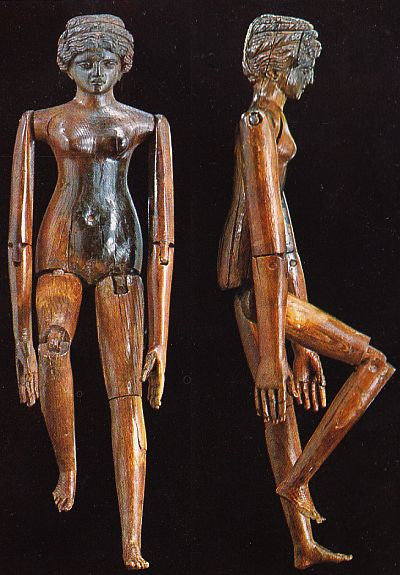
(this doll had fucking JEWELRY. and G*rwig says Barbie was the first fashion doll? give me a break)
honestly, most of the Firsts or Onlys people want to attribute to Barbie aren't real.
"but she was the first fashion doll meant for play, not just showing off clothing!"
there's actually less evidence of dolls meant only for displaying new fashions in history than dolls intended for children to play with AND to incidentally show their mothers and older sisters the latest styles. even so-called "milliners' models" of the late 18th-early 19th century are now believed to have been primarily toys
"but she was the first one with a [cis] woman's body!"
see above. the ancient Roman doll has breasts. she was not the last doll with breasts before Barbie- and lots of the intervening lady dolls weren't flat due to prudishness as many suppose, but because the same bodies were often used for male dolls. saves money, work, and time to just bang out a bunch of gender-neutral stuffed or carved bodies and let the clothes and hair determine the gender. Creatable World isn't new, either
the reson for Barbie's massive success wasn't that she was the First Fashion Doll in a sea of baby dolls. it's that she filled a very specific niche that was empty when she came along: a small, relatively affordable fashion doll that gave a 3-D paper doll experience. (Everyone likes to talk about Barbie's roots with the Bild Lilli doll; nobody brings up that Ruth Handler was equally inspired by her daughter's movie star paper dolls.)
lady dolls WERE scarce when Barbie came out, and she DID face pushback for her adult, somewhat sexy look. That's true. But she was not unique in history- she was just the right idea, in the right place, at the right time
#ask#anon#dolls#doll history#ancient history#ancient rome#barbie#I don't hate barbie or anything! I have two vintage Barbies who are married and changing their clothes seasonally delights me#I just hate Mattel stealing earlier fashion dolls' thunder
374 notes
·
View notes
Text

This is the Crepereia doll, once owned by a young woman called Crepereia Tryphaena.
Crepereia Tryphaena was a young Roman woman, presumably about 20 years old, whose sarcophagus was found during the excavation works started in 1889 for the foundations of the Palace of Justice and for the construction of the Umberto I bridge over the Tiber in Rome.
This extraordinary ancient Barbie doll is made of ivory, which got darkened by water. The head and torso are carved in one piece, while the limbs are designed so with movable joints. This denotes an extremely high level of craftsmanship.
The doll might have been originally dressed since - unlike its trunk - its hands, feet and head have been carved with extremely high detail. The doll's hairstyle was typical of the last decade of Anoninus Pius' Age.
📷 Giovanni Tiso
216 notes
·
View notes
Text

My girlfriend Crepereia Tryphaena
14 notes
·
View notes
Text
Why is Cleopatra white?
I saw THAT trailer and now I need to write this 'cause this the x times that this argument is trending.
1- Cleopatra VII Philopator ( the father beloved ) was a Greek Queen in an Egyptian Empire, or even better an Hellenistic Empire
1B - Hellenistic Period: "Hellenistic" is distinguished from "Hellenic" in that the latter refers to Greece itself, while the former encompasses all ancient territories under Greek influence, in particular the East after the conquests of Alexander the Great." via wikipedia eng
2- Hellenistic Empire were ruled by Macedonian men, descendent from Alexander's generals. I used the term "Macedonian" 'cause the Greek were very racist and they saw Macedonians as inferior, almost barbaric
2B- Barbarian: a person who don't speak Greek or follow Greek costumes so a non-Greek
2C - I know, Greek and Macedonia are really close but Greek were racist
3 - Cleopatra's ancestor was general Ptolemy I, Ptolemy Soter aka Ptolemy the savoir. Or he was called " Lagide" as "son of Lago".
4- Ptolemy was married 3 times: with a Persian princess and with two Macedonian noblewoman Euridyce and Berenice, Euridyce'cousin.
5- Ptolemy decided that his sons must follow the Egyptian ways when it comes to marriage so incestous marriage between brother and sister, or half brothers.
6 - From him to Cleopatra VII the Ptolemaic pharaohs always married their sisters, their aunt, their cousins, sometimes even their daughters, the last only spiritually to be clear. The only exception was Ptolemy V who married Cleopatra I, a Seleucid princess
6B Seleucid were Macedian too
7- Cleopatra was inbreed 'cause the Ptolemaic were fully Targaryen, even more
8- we don't know her mother but even if she was a Nubian woman or an Egyptian... she could not be black but mixed race
9- Assuming her mother was not Cleopatra Tryphaena, Ptolemy's sister AND wife, it's not possible she's could be black 'cause Egyptian are not black, they never were
9B ther's a Nubian dynasty who ruled Egypt but they were an unicum
Conclusion: Cleopatra was white 'cause genetically her ancestor never mixed with natives aristocracy.
I know how rep is importan, I'm a latina woman who growp up In Italy via adoption, but I'm an historian too and while I defend rep I defend only GOOD and real rep.
11 notes
·
View notes
Text
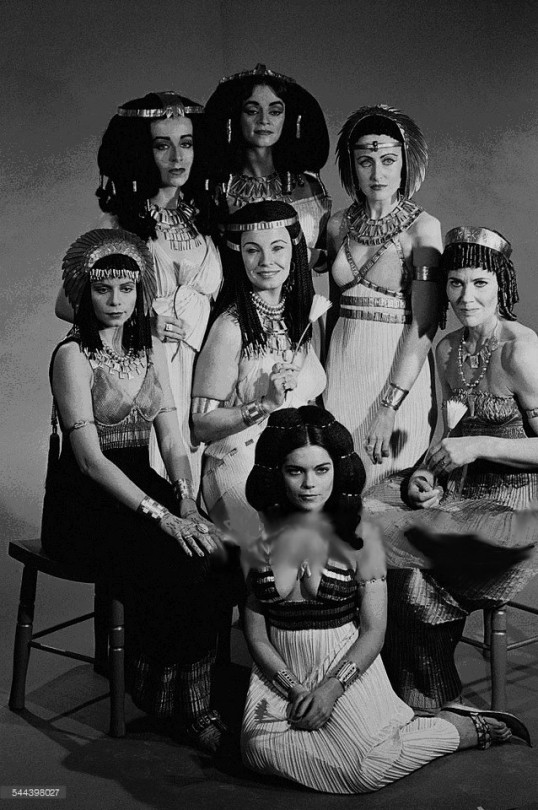
Female cast members of the BBC television drama series "The Cleopatras" pictured together in Ancient Egyptian period costume in London on 29th November 1982. Clockwise from top rear: Sue Holderness (Cleopatra IV), Pauline Moran (Cleopatra Berenike), Caroline Mortimer (Cleopatra Thea, Queen of Syria), Francesca Gonshaw (Arsinoe IV), Michelle Newell (Cleopatra III + Cleopatra VII, here she’s in costume as Cleopatra VII), Amanda Boxer (Cleopatra Tryphaena, Queen of Syria), and Elizabeth Shepherd (Cleopatra II) (center).
#The Cleopatras#TV#Sue Holderness#Pauline Moran#Caroline Mortimer#Francesca Gonshaw#Michelle Newell#Amanda Boxer#Elizabeth Shepherd
3 notes
·
View notes
Text
Dissertation Diary #2
Chapters:
My dissertation has three chapters.
In the first chapter, I analyze Augustus relation to theatricality. Augustus and Nero have a lot more in common than we like to admit. This section involves an examination of the sources for examples of Augustus' habit of pretense. This leads us to the environment of pretense that that developed during the proscriptions of 43 BCE under the then Octavian, Antony, and Lepidus. The similarities between how that period is described in our sources and the overall setting of the Satyrica is revealing. Both show the breakdown or nonexistence of normative family structures. A possible explanation for this is that the Satyrica exists in the fallout of a society ransacked by civil war and proscription.
In the second chapter, currently titled Imperial Metaphors in the Cena Trimalchionis, I argue that at Trimalchio's dinner we encounter a series of grand metaphors. Working from the grandest of metaphors backwards, then, we begin with the evidence for seeing Trimalchio’s estate as depicting the imperium Romanum under his control. Then we zoom in closer to Trimalchio’s home representing Rome itself and including physical aspects specific to Augustus and his family. Then Trimalchio and the other freedmen and freedwomen, who represent a grand metaphor within this Roman microcosm where there are only two kinds of people, freed and enslaved. Through this approach we see that Petronius is not giving us a realistic depiction of a close-knit group of freedmen, but instead a hyper-mimetic imitation of the culture of the principes themselves.
The third is Semper Femina: Petronian Women and their Augustan Connections. This chapter focuses on four of the women in the Satyrica (Quartilla, Tryphaena, The Widow of Ephesus, and Circe). With each I draw attention to the possible ways that they Petronian women express their sexuality while challenging an Augustan moral culture. I also argue in this chapter that we see Petronius alluding to female relatives of Augustus further drawing out attention to the reality that contradicts the Augustan ideal concerning women.
4 notes
·
View notes
Text

Cleopatra VII Thea Philopator (69 BC – August 10, 30 BC) was Queen of the Ptolemaic Kingdom of Egypt (51-30 BC) and its last active ruler. A member of the Ptolemaic dynasty, she was a descendant of its founder Ptolemy I Soter, a Macedonian Greek general and companion of Alexander the Great. Her first language was Koine Greek, and she is the only Ptolemaic ruler known to have learned the Egyptian language. After her death, Egypt became a province of the Roman Empire, marking the end of the last Hellenistic-period state in the Mediterranean, a period which had lasted since the reign of Alexander (336–323 BC).
She was born to the ruling Ptolemaic pharaoh Ptolemy XII and an uncertain mother, presumably Ptolemy XII’s wife Cleopatra V Tryphaena (who may have been the same person as Cleopatra VI Tryphaena) the mother of Cleopatra’s older sister, Berenice IV Epiphaneia. Cleopatra Tryphaena disappears from official records a few months after the birth of Cleopatra in 69 BC. The three younger children of Ptolemy XII, Cleopatra’s sister Arsinoe IV, and brothers Ptolemy XIII Theos Philopator and Ptolemy XIV were born in the absence of his wife. Her childhood tutor was Philostratos, from whom she learned the Greek arts of oration and philosophy. During her youth, she studied at the Museum, including the Library of Alexandria. #africanhistory365 #africanexcellence
0 notes
Text
THE BIBLE BOOK OF GOD
New Testament
Romans 16
Personal Greetings
16 I commend to you our sister Phoebe, a servant of the church at Cenchreae, 2 that you may welcome her in the Lord in a way worthy of the saints, and help her in whatever she may need from you, for she has been a patron of many and of myself as well.
3 Greet Prisca and Aquila, my fellow workers in Christ Jesus, 4 who risked their necks for my life, to whom not only I give thanks but all the churches of the Gentiles give thanks as well. 5 Greet also the church in their house. Greet my beloved Epaenetus, who was the first convert to Christ in Asia. 6 Greet Mary, who has worked hard for you. 7 Greet Andronicus and Junia, my kinsmen and my fellow prisoners. They are well known to the apostles, and they were in Christ before me. 8 Greet Ampliatus, my beloved in the Lord. 9 Greet Urbanus, our fellow worker in Christ, and my beloved Stachys. 10 Greet Apelles, who is approved in Christ. Greet those who belong to the family of Aristobulus. 11 Greet my kinsman Herodion. Greet those in the Lord who belong to the family of Narcissus. 12 Greet those workers in the Lord, Tryphaena and Tryphosa. Greet the beloved Persis, who has worked hard in the Lord. 13 Greet Rufus, chosen in the Lord; also his mother, who has been a mother to me as well. 14 Greet Asyncritus, Phlegon, Hermes, Patrobas, Hermas, and the brothers who are with them. 15 Greet Philologus, Julia, Nereus and his sister, and Olympas, and all the saints who are with them. 16 Greet one another with a holy kiss. All the churches of Christ greet you.
Final Instructions and Greetings
17 I appeal to you, brothers, to watch out for those who cause divisions and create obstacles contrary to the doctrine that you have been taught; avoid them. 18 For such persons do not serve our Lord Christ, but their own appetites, and by smooth talk and flattery they deceive the hearts of the naive. 19 For your obedience is known to all, so that I rejoice over you, but I want you to be wise as to what is good and innocent as to what is evil. 20 The God of peace will soon crush Satan under your feet. The grace of our Lord Jesus Christ be with you.
21 Timothy, my fellow worker, greets you; so do Lucius and Jason and Sosipater, my kinsmen.
22 I Tertius, who wrote this letter, greet you in the Lord.
23 Gaius, who is host to me and to the whole church, greets you. Erastus, the city treasurer, and our brother Quartus, greet you.
Doxology
25 Now to him who is able to strengthen you according to my gospel and the preaching of Jesus Christ, according to the revelation of the mystery that was kept secret for long ages 26 but has now been disclosed and through the prophetic writings has been made known to all nations, according to the command of the eternal God, to bring about the obedience of faith— 27 to the only wise God be glory forevermore through Jesus Christ! Amen.
Romans 16
Diane Beauford
0 notes
Photo

Arsinoë IV
Arsinoë IV (d. 41 BCE) was a Ptolemaic princess who rebelled against her sister Cleopatra VII during the Alexandrian War in 48 BCE. After being defeated by Cleopatra's ally Julius Caesar, she was a captive in his Roman triumph. Arsinoë later became a priestess at the Temple of Artemis at Ephesus until Mark Antony and Cleopatra had her assassinated.
Early Life & Background
Arsinoë was the daughter of Ptolemy XII Auletes (r. 80-51 BCE), king of Ptolemaic Egypt. She had two sisters, Berenike IV (r. 58-55 BCE) and Cleopatra VII (l. 70/69-30 BCE), and two brothers, Ptolemy XIII (l. 62/61-47 BCE) and Ptolemy XIV (l. 60/59-44 BCE). Her exact age is not mentioned by ancient sources, but she was younger than her sisters and older than her brothers. By the time Arsinoë was born, Ptolemy XII's wife Cleopatra V Tryphaena had disappeared from Egyptian inscriptions. It is unknown whether this is because Cleopatra Tryphaena died or because they divorced. Arsinoë's mother was an unknown wife or concubine of the king.
Arsinoë was probably born in the capital city Alexandria. Because she was not in line for the crown, contemporary writers paid little attention to her, and nothing is known of her childhood. Like all women in the Ptolemaic dynasty, she would have received an education in areas like politics and Greek philosophy. Her tutor was a eunuch named Ganymedes, who also acted as her legal guardian. She would also have been expected to become proficient in horseback riding.
In 58 BCE, Berenike IV usurped the throne of Ptolemy XII and declared herself queen. Cleopatra and Arsinoë are thought to have accompanied their father when he went into exile. Searching for an army capable of restoring his throne, Ptolemy XII went to Rome where he had made allies by bribing politicians like Julius Caesar and Pompey the Great. Pompey instructed his general Aulus Gabinius to help Ptolemy XII reconquer Egypt in 56 BCE. The victorious king had Berenike executed and made Cleopatra VII his co-ruler.
Continue reading...
38 notes
·
View notes
Text




In Rome in the spring of 1889, while in the process of building what would become the Palace of Justice, a burial vault was discovered eight metres under the earth and inside was a sarcophagus. The Tiber River had overflowed and the coffin was in water; when they removed the cover, they saw the remains of a female, her head turned to face the browned ivory doll lying by her side. The funerary inscription simply read: Crepereia Tryphaena, her name.
She was buried in what was thought to be her wedding dress and a few other accessories, and her age was determined to be between thirteen and twenty. The manner of her death is unknown. On her finger was a golden ring with the name Filetus inscribed on it. They believe that because she was buried with her doll, it is possible the ceremony had not actually taken place yet. Due to the custom of offering a toy to Venus or the Lares on the wedding day,
The doll wore its own wedding ring on its finger and had probably once worn a dress similar to the girl. Attached to the ring on the doll's finger was a key that opened a tiny box, with its own belongings mirroring those of the girl it belonged to.
Source: Facebook
The Tudor Intruders
Musei Capitolini, Rome
0 notes